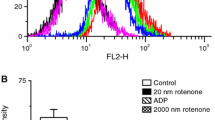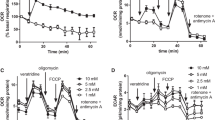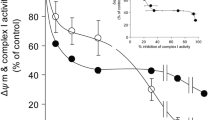Abstract
The role of ubiquitous mitochondrial creatine kinase (uMtCK) reaction in regulation of mitochondrial respiration was studied in purified preparations of rat brain synaptosomes and mitochondria. In permeabilized synaptosomes, apparent Km for exogenous ADP, Km (ADP), in regulation of respiration in situ was rather high (110 ± 11 μM) in comparison with isolated brain mitochondria (9 ± 1 μM). This apparent Km for ADP observed in isolated mitochondria in vitro dramatically increased to 169 ± 52 μM after their incubation with 1 μM of dimeric tubulin showing that in rat brain, particularly in synaptosomes, mitochondrial outer membrane permeability for ADP, and ATP may be restricted by tubulin binding to voltage dependent anion channel (VDAC). On the other hand, in synaptosomes apparent Km (ADP) decreased to 25 ± 1 μM in the presence of 20 mM creatine. To fully understand this effect of creatine on kinetics of respiration regulation, complete kinetic analysis of uMtCK reaction in isolated brain mitochondria was carried out. This showed that oxidative phosphorylation specifically altered only the dissociation constants for MgATP, by decreasing that from ternary complex MtCK.Cr.MgATP (K a) from 0.13 ± 0.02 to 0.018 ± 0.007 mM and that from binary complex MtCK.MgATP (K ia) from 1.1 ± 0.29 mM to 0.17 ± 0.07 mM. Apparent decrease of dissociation constants for MgATP reflects effective cycling of ATP and ADP between uMtCK and adenine nucleotide translocase (ANT). These results emphasize important role and various pathophysiological implications of the phosphocreatine–creatine kinase system in energy transfer in brain cells, including synaptosomes.














Similar content being viewed by others
Abbreviations
- CK:
-
Creatine kinase
- uMtCK:
-
Ubiquitous mitochondrial creatine kinase
- sMtCK:
-
Sarcomeric mitochondrial creatine kinase
- Cr:
-
Creatine
- PCr:
-
Phosphocreatine
- ANT:
-
Adenine nucleotide translocase
- VDAC:
-
Voltage dependent anion channel
- DTT:
-
Dithiothreitol
- SDS:
-
Sodium dodecyl sulfate
- PEP:
-
Phosphoenol pyruvate
- PK:
-
Pyruvate kinase
References
Ames AIII (2000) CNS energy metabolism as related to function. Brain Res Brain Res Rev 34:42–68. doi:10.1016/S0165-0173(00)00038-2
Nicholls DG (2003) Bioenergetics and transmitter release in the isolated nerve terminal. Neurochem Res 2:1433–1441. doi:10.1023/A:1025653805029
Wyss M, Smeitink J, Wevers RA, Wallimann T (1992) Mitochondrial creatine kinase, a key enzyme of aerobic energy metabolism. Biochim Biophys Acta 1102:119–166. doi:10.1016/0005-2728(92)90096-K
Saks VA, Ventura-Clapier R (eds) (1994) Role of coupled creatine kinase. In: Cellular Bioenergetics. Kluwer Academic Publishers, Dordrecht-Boston, pp 1–348
Saks VA (ed) (2007) Molecular system bioenergetics. Wiley–VCH Verlag, Weinheim, pp 1–604
Wyss M, Kaddurah-Daouk R (2000) Creatine and creatinine metabolism. Physiol Rev 80:1107–1213
Dzeja P, Terzic A (2003) Phosphotransfer networks and cellular energetics. J Exp Biol 206:2039–2047. doi:10.1242/jeb.00426
Schlattner U, Wallimann T (2004) Metabolite channeling: creatine kinase microcompartments. In: Lennarz WJ, Lane MD (eds) Encyclopedia of biological chemistry. Academic Press, New York, pp 646–651
Saks V, Dzeja P, Schlattner U et al (2006) Cardiac system bioenergetics: metabolic basis of the Frank-Starling law. J Physiol 571:253–273. doi:10.1113/jphysiol.2005.101444
Saks V, Vendelin M, Aliev MK et al (2007) Mechanisms and modeling of energy transfer between and among intracellular compartments. In: Gibson GF, Dienel G (eds) Brain energetics: integration of molecular and cellular processes. Handbook of neurochemistry and molecular neurobiology. Abel Lajtha (Editor-in-Chief), vol 5. Springer, Berlin
Caldwell PC, Hodgkin AL, Keynes RD et al (1960) The effects of injecting “energy rich” phosphate compounds on the active transport of ions in the giant axons of Loligo. J Physiol 152:561–590
Caldwell PC, Hodgkin AL, Keynes RD et al (1964) The rate of formation and turnover of phosphorus compounds in squid giant axons. J Physiol 171:119–131
Hodgkin AL (1964) The conduction of nervous impulse. Liverpool University Press, Liverpool, pp 80–85
Friedman DL, Roberts R (1994) Compartment of brain-type creatine kinase and ubiquitous mitochondrial creatine kinase in neurons: evidence for a creatine phosphate energy shuttle in adult rat brain. J Comp Neurol 343:500–511. doi:10.1002/cne.903430311
Wallimann T, Hemmer W (1994) Creatine kinase in non-muscle tissues and cells. Mol Cell Biochem 133/134:13–220. doi:10.1007/BF01267955
Erecinska M, Nelson D, Silver IA (1996) Metabolic and energetic properties of isolated nerve ending particles (synaptosomes). Biochim Biophys Acta 1277:13–34. doi:10.1016/S0005-2728(96)00103-X
Erecinska M, Cherian S, Silver IA (2004) Energy metabolism in mammalian brain during development. Prog Neurobiol 73:397–445. doi:10.1016/j.pneurobio.2004.06.003
Dzeja PP, Terzic A (2005) Mitochondrial-nucleus energetic communication: role of phosphotransfer networks in processing cellular information. In Gibson G, Dienel G (eds) Brain energetics: integration of molecular and cellular processes (2007). In: Handbook of neurochemistry and molecular neurobiology, Abel Lajtha, (Editor-in-Chief), vol 5. Springer, Berlin
Walllimann T, Tokarska-Schlattner M, Neumann DR (2007) The phosphocreatine circuit: molecular and cellular physiology of creatine kinases, sensitivity to free radicals and enhancement by creatine supplementation. In: Saks V (ed) Molecular system bioenergetics. Wiley–VCH Verlag, Weinheim, pp 195–294
Gibson GF, Dienel G (eds) (2007) Brain energetics: integration of molecular and cellular processes. In: Lajtha A (Editor-in-Chief) Handbook of neurochemistry and molecular neurobiology, vol 5. Springer, Berlin, pp 1–924
Chen C, Ko Y, Delannoy M et al (2004) Mitochondrial ATP synthasome: three-dimensional structure by electron microscopy of the ATP synthase in complex formation with carriers for Pi and ADP/ATP. J Biol Chem 279:31761–31768. doi:10.1074/jbc.M401353200
Vendelin M, Eimre M, Seppet E et al (2004) Intracellular diffusion of adenosine phosphates is locally restricted in cardiac muscle. Mol Cell Biochem 256/257:229–241. doi:10.1023/B:MCBI.0000009871.04141.64
Saks V, Kuznetsov A, Khuchua Z et al (1995) Control of cellular respiration in vivo by mitochondrial outer membrane and by creatine kinase. A new speculative hypothesis: possible involvment of mitochondrial-cytoskeleton interactions. J Mol Cell Cardiol 27:625–645. doi:10.1016/S0022-2828(08)80056-9
Saks V, Kuznetsov A, Andrienko T et al (2003) Heterogeneity of ADP diffusion and regulation of respiration in cardiac cells. Biophys J 84:3436–3456
Carré M, André N, Carles G et al (2002) Tubulin is an inherent component of mitochondrial membranes that interacts with the voltage-dependent anion channel. J Biol Chem 277:33664–33669. doi:10.1074/jbc.M203834200
Appaix F, Kuznetsov AV, Usson Y et al (2003) Possible role of cytoskeleton in intracellular arrangement and regulation of mitochondria. Exp Physiol 88:175–190. doi:10.1113/eph8802511
Scott ID, Nicholls DG (1980) Energy transduction in intact synaptosomes. Influence of plasma-membrane depolarization on the respiration and membrane potential of internal mitochondria determined in situ. Biochem J 186:21–33
Scott ID, Akerman KE, Nicholls DG (1980) Calcium-ion transport by intact synaptosomes. Intrasynaptosomal compartmentation and the role of the mitochondrial membrane potential. Biochem J 192:873–880
Booth RF, Clark JB (1978) A rapid method for the preparation of relatively pure metabolically competent synaptosomes from rat brain. Biochem J 176:365–370
Sackett DL, Knipling L, Wolff J (1991) Isolation of microtubule protein from mammalian brain frozen for extended periods of time. Protein Expr Purif 2:390–393. doi:10.1016/1046-5928(91)90099-5
Wolff J, Sackett DL, Knipling L (1996) Cation selective promotion of tubulin polymerization by alkali metal chlorides. Protein Sci 5:2020–2028
Saks VA, Veksler VI, Kuznetsov AV et al (1998) Permeabilized cell and skinned fiber techniques in studies of mitochondrial function in vivo. Mol Cell Biochem 184:81–100. doi:10.1023/A:1006834912257
Gnaiger E, Kuznetsov AV, Schneeberger S et al (2000) Mitochondria in the cold. In: Heldmaier G, Klingenspor M (eds) Life in the cold. Springer, Heidelberg, pp 431–442
Kuznetsov AV, Schneeberger S, Seiler R et al (2004) Mitochondrial defects and heterogeneous cytochrome c release after cardiac cold ischemia and reperfusion. Am J Physiol Heart Circ Physiol 286:H1633–H1641. doi:10.1152/ajpheart.00701.2003
Miller DJ, Smith GL (1984) EGTA purity and the buffering of calcium ions in physiological solutions. Am J Physiol 246:C160–C166
Gnaiger E (2001) Oxygen solubility in experimental media. OROBOROS Bioenergetics Newsletter 6.3, Innsbruck
Van Gelder BF (1966) On cytochrome c oxidase I. The extinction coefficients of cytochrome a and cytochrome a3. Biochim Biophys Acta 118:36–46
Segel IH (1975) Enzyme kinetics. Wiley Interscience Publishers, New York, pp 1–957
Cleland WW (1963) The kinetics of enzyme-catalyzed reactions with two or more substrates or products. I. Nomenclature and rate equations. Biochim Biophys Acta 67:104–137. doi:10.1016/0006-3002(63)91800-6
Cleland WW (1963) The kinetics of enzyme-catalyzed reactions with two or more substrates or products. II. Inhibition: nomenclature and theory. Biochim Biophys Acta 67:173–187. doi:10.1016/0006-3002(63)91815-8
Jacobus WE, Saks VA (1982) Creatine kinase of heart mitochondria: changes in its kinetic properties induced by coupling to oxidative phosphorylation. Arch Biochem Biophys 219:167–178. doi:10.1016/0003-9861(82)90146-1
Kenyon GL, Reed GH (1983) Creatine kinase: structure-activity relationships. Adv Enzymol 54:367–426
Saks VA, Kuznetsov AV, Kupriyanov VV et al (1985) Creatine kinase of rat heart mitochondria. The demonstration of functional coupling to oxidative phosphorylation in an inner membrane-matrix preparation. J Biol Chem 260:7757–7764
Kuznetsov AV, Khuchua ZA, Vassil’eva EV et al (1989) Heart mitochondrial creatine kinase revisited: the outer mitochondrial membrane is not important for coupling of phosphocreatine production to oxidative phosphorylation. Arch Biochem Biophys 268:176–190. doi:10.1016/0003-9861(89)90578-X
McLeish MJ, Kenyon GL (2005) Relating structure to mechanism in creatine kinase. Crit Rev Biochem Mol Biol 40:1–20. doi:10.1080/10409230590918577
Cornish-Bowden A (2004) Fundamentals of enzyme kinetics. Portland Press, London, pp 1–422
Chen G, Porter MD, Bristol JR et al (2000) Kinetic mechanism of the p38-α MAP kinase: phosphoryl transfer to synthetic peptides. Biochemistry 39:2079–2087. doi:10.1021/bi9919495
Szafranska AE, Dalby KN (2005) Kinetic mechanism for p38 MAP kinase alpha. A partial rapid-equilibrium random-order ternary-complex mechanism for the phosphorylation of a protein substrate. FEBS J 272:4631–4645. doi:10.1111/j.1742-4658.2005.04827.x
Smith PK, Krohn RI, Hermanson GT et al (1985) Measurement of protein using bicinchoninic acid. Anal Biochem 150:76–85. doi:10.1016/0003-2697(85)90442-7
Gupte S, Hackenbrock C (1988) The role of cytochrome c diffusion in mitochondrial electron transport. J Biol Chem 263:5248–5253
Appaix F, Guerrero K, Rampal D et al (2002) Bax and heart mitochondria: uncoupling and inhibition of oxidative phosphorylation without permeability transition. Biochim Biophys Acta 1556:155–167. doi:10.1016/S0005-2728(02)00358-4
Rossi A, Kay L, Saks VA (1998) Early ischemia-induced alterations of the outer mitochondrial membrane and the intermembrane space: a potential cause for altered energy transfer in cardiac muscle? Mol Cell Biochem 184:209–229. doi:10.1023/A:1006874825403
Friedhoff AJ, Lerner MH (1977) Creatine kinase isoenzyme associated with synaptosomal membrane and synaptic vesicles. Life Sci 20:867–873. doi:10.1016/0024-3205(77)90039-X
Scholte HR, Weijers PJ, Wit-Peeters EM (1973) The localization of mitochondrial creatine kinase, and its use for the determination of the sidedness of submitochondrial particles. Biochim Biophys Acta 291:764–773. doi:10.1016/0005-2736(73)90479-3
Muller M, Moser R, Cheneval D et al (1985) Cardiolipin is the membrane receptor for mitochondrial creatine phosphokinase. J Biol Chem 260:3839–3843
Schlattner U, Gehring F, Vernoux N et al (2004) C-terminal lysines determine phospholipid interaction of sarcomeric mitochondrial creatine kinase. J Biol Chem 279:24334–24342. doi:10.1074/jbc.M314158200
Jacobus WE, Lehninger AL (1973) Creatine kinase of rat heart mitochondria. Coupling of creatine phosphorylation to electron transport. J Biol Chem 248:4803–4810
Meyer LE, Machado LB, Santiago AP et al (2006) Mitochondrial creatine kinase activity prevents reactive oxygen species generation: antioxidant role of mitochondrial kinase-dependent ADP re-cycling activity. J Biol Chem 49:37361–37371. doi:10.1074/jbc.M604123200
Jacobs HK, Kuby SA (1970) Studies on adenosine triphosphate transphosphorylases. IX. Kinetic properties of the crystalline adenosine triphosphate-creatine transphosphorylase from calf brain. J Biol Chem 245:3305–3314
Matsushima K, Uda K, Ishida K et al (2006) Comparison of kinetic constants of creatine kinase isoforms. Int J Biol Macromol 38:83–88. doi:10.1016/j.ijbiomac.2005.12.023
Saks VA, Kaambre T, Sikk P et al (2001) Intracellular energetic units in red muscle cells. Biochem J 356:643–657. doi:10.1042/0264-6021:3560643
Vendelin M, Lemba M, Saks VA (2004) Analysis of functional coupling: mitochondrial creatine kinase and adenine nucleotide translocase. Biophys J 87:696–713. doi:10.1529/biophysj.103.036210
Bernier-Valentin F, Rousset B (1982) Interaction of tubulin with rat liver mitochondria. J Biol Chem 257:7092–7099
Rostovtseva T, Hassanzadeh E, Sackett DL et al (2007). Tubulin regulates VDAC channel. Biophys J Abstr Issue 2088-Pos/B305
Saks VA, Chernousova GB, Gukovsky DE et al (1975) Studies of energy transport in heart cells. Mitochondrial isoenzyme of creatine phosphokinase: kinetic properties and regulatory action of Mg2+ ions. Eur J Biochem 57:273–290. doi:10.1111/j.1432-1033.1975.tb02299.x
Lim L, Hall C, Leung T et al (1983) Neurone-specific enolase and creatine phosphokinase are protein components of rat brain synaptic plasma membranes. J Neurochem 41:1177–1182. doi:10.1111/j.1471-4159.1983.tb09069.x
Leterrier JF, Rusakov DA, Nelson BD, Linden M (1994) Interactions between brain mitochondria and cytoskeleton: evidence for specialized outer membrane domains involved in the association of cytoskeleton-associated proteins to mitochondria in situ and in vitro. Microsc Res Tech 27(3):233–261
Capetanaki Y (2002) Desmin cytoskeleton: a potential regulator of muscle mitochondrial behavior and function. Trends Cardiovasc Med 8:339–348. doi:10.1016/S1050-1738(02)00184-6
Yaffe MP (1999) The machinery of mitochondrial inheritance and behavior. Science 283:1493–1497. doi:10.1126/science.283.5407.1493
Kuznetsov A (2007) Structural organization and dynamics of mitochondria in the cells in vivo. In: Saks V (ed) Molecular system bioenergetics. Wiley–VCH Verlag, Weinheim, pp 137–162
Vendelin M, Béraud N, Guerrero K (2005) Mitochondrial regular arrangement in muscle cells: a “crystal-like” pattern. Am J Physiol Cell Physiol 288:C757–C767. doi:10.1152/ajpcell.00281.2004
Chang DT (2006) Mitochondrial trafficking to synapses in cultures primary cortical neurons. J Neurosci 26:7035–7045. doi:10.1523/JNEUROSCI.1012-06.2006
Lindén M, Nelson BD, Leterrier JF (1989) The specific binding of the microtubule-associated protein 2 (MAP2) to the outer membrane of rat brain mitochondria. Biochem J 261:167–173
Song J, Midson C, Blachly-Dyson E et al (1998) The sensor regions of VDAC are translocated from within the membrane to the surface during gating process. Biophys J 74:2926–2944
Rostovtseva T, Colombini M (1997) VDAC channels mediate and gate the flow of ATP: implications for the regulation of mitochondrial function. Biophys J 72:1954–1962
Wallimann T, Schlattner U, Guerrero L et al (1999) The phosphocreatine circuit and creatine supplementation, both come of age. In: Mori A, Ishida M, Clark J (eds) Guanidino compounds in biology and medicine. Blackwell Science Inc, pp 117–129
Wyss M, Schulze A (2002) Health implications of creatine: can oral creatine supplementation protect against neurological and atherosclerotic disease? Neuroscience 112:243–260. doi:10.1016/S0306-4522(02)00088-X
Jost CR, Van Der Zee CE, In ‘t Zandt HJ et al (2002) Creatine kinase B-driven energy transfer in the brain is important for habituation and spatial learning behaviour, mossy fiber field size and determination of seizure susceptibility. Eur J Neurosci 15:1692–1706
in ‘t Zandt HJ, Renema WK, Streijger F et al (2004) Cerebral creatine kinase deficiency influences metabolite levels and morphology in the mouse brain: a quantitative in vivo 1H and 31P magnetic resonance study. J Neurochem 90:1321–1330
Streijger F, Oerlemans F, Ellenbroek BA et al (2005) Structural and behavioural consequences of double deficiency for creatine kinases BCK and UbCKmit. Behav Brain Res 157:219–234. doi:10.1016/j.bbr.2004.07.002
Couzin J (2007) Clinical research. Testing a novel strategy against Parkinson’s disease. Science 315:1778. doi:10.1126/science.315.5820.1778
Andres RH, Ducray AD, Schlattner U et al (2008) Functions and effects of creatine in the central nervous system. Brain Res Bull 76:329–343. doi:10.1016/j.brainresbull.2008.02.035
Acknowledgments
This work was supported by INSERM, France; Agence National de la Recherche (project n° BLAN07-2_188128), France, to C.M. and V.S.; grants of Estonian Science Foundation (N° 6142 and 7117 to V.S.).
Author information
Authors and Affiliations
Corresponding author
Rights and permissions
About this article
Cite this article
Monge, C., Beraud, N., Kuznetsov, A.V. et al. Regulation of respiration in brain mitochondria and synaptosomes: restrictions of ADP diffusion in situ, roles of tubulin, and mitochondrial creatine kinase. Mol Cell Biochem 318, 147–165 (2008). https://doi.org/10.1007/s11010-008-9865-7
Received:
Accepted:
Published:
Issue Date:
DOI: https://doi.org/10.1007/s11010-008-9865-7




